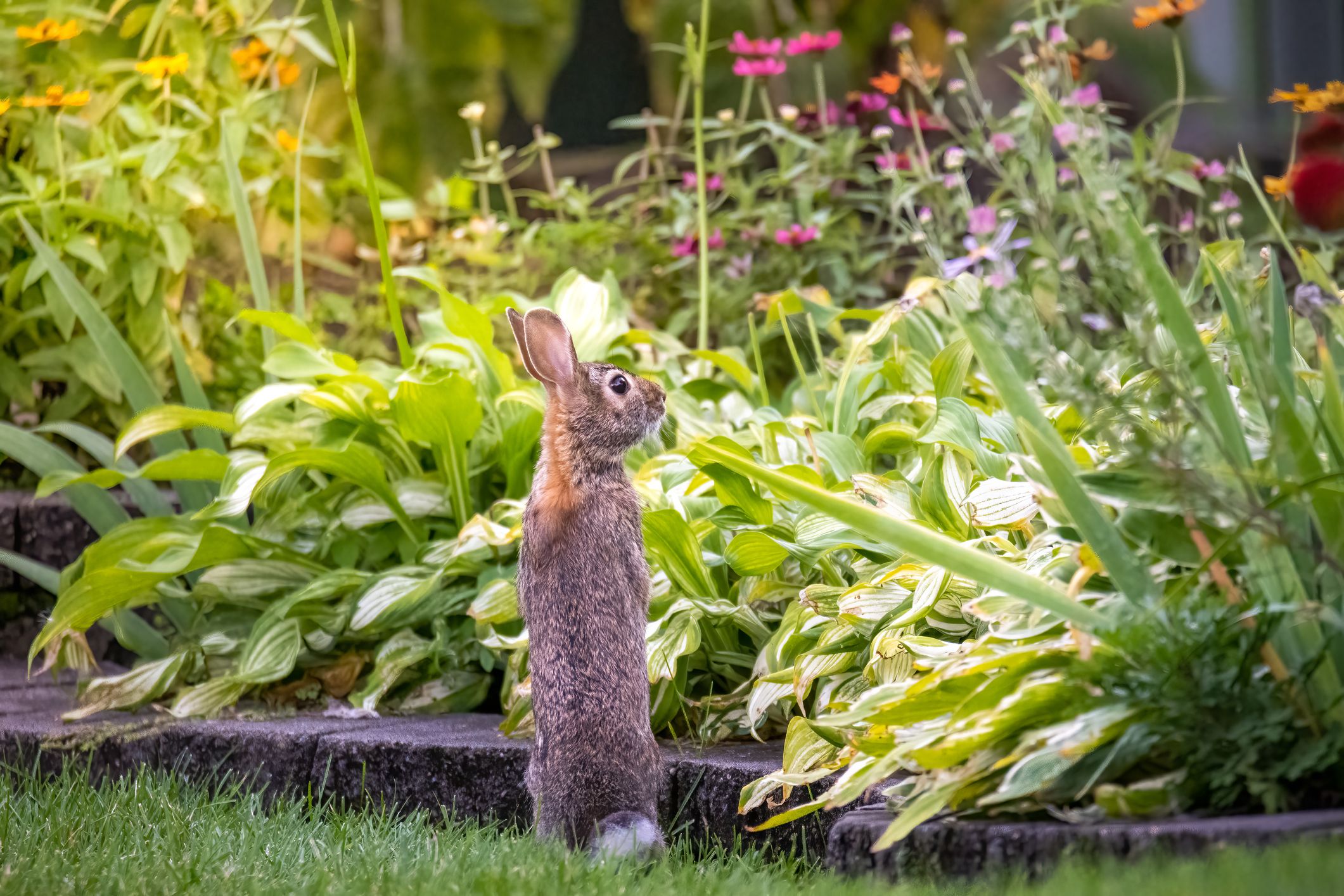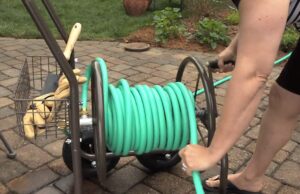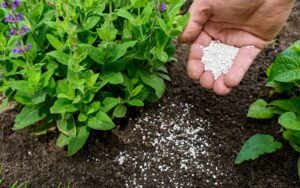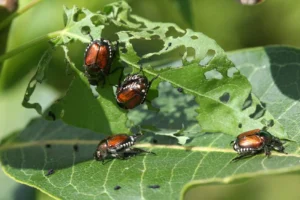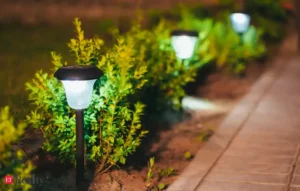How to Keep Rabbits Out of Garden: Protect Your Plants With Natural Deterrents
The Persistent Challenge of Garden Rabbits
Few garden pests prove as persistently challenging as rabbits. These furry visitors can transform meticulously tended vegetable patches and ornamental borders into their personal salad bars overnight. Many gardeners have experienced the frustration of discovering seedlings reduced to stubs, flowers decapitated, and prized plants damaged beyond recovery. While these creatures are undeniably charming in natural settings, their presence in cultivated gardens requires thoughtful management strategies.
Understanding rabbit behavior is the first step toward effective garden protection. These small mammals cause extensive damage to gardens by grazing on a wide range of plants and can kill young trees, shrubs, and herbaceous plants. Rabbits typically do most of their feeding between dusk and dawn but can also be active during daylight hours. Their presence is often easily identified by spherical droppings and distinctive damage patterns.
Identifying Rabbit Damage in Your Garden
Before implementing deterrents, it’s important to confirm that rabbits are indeed your garden intruders. Rabbit damage has distinctive characteristics – they make clean, 45-degree cuts in young stems and can reach only approximately 3 feet high, unlike deer damage which appears ragged and can reach up to 6 feet. Common signs of rabbit activity include:
- Young plants nibbled down to ground level
- Soft shoots cleanly cut at a 45-degree angle
- Bark gnawed from the base of trees and shrubs, especially in winter
- Distinctive spherical droppings in the garden area
- Small, shallow holes or scrapes in lawns and flower beds
Young, tender leaves are most susceptible to rabbit damage, though rabbits will sample many plants in vegetable gardens. Plants that are tender and out in the open with no protection typically sustain the most damage.
Understanding What Attracts Rabbits to Gardens
Rabbits are drawn to gardens for several reasons. Gardens become particularly attractive to rabbits when they lack predators such as dogs or cats, offer easy access, and provide cover. While not all gardens will appeal to rabbits equally, they may still enter any area when searching for food or water.
Rabbits prefer environments that provide:
- Abundant food sources (vegetables, flowers, young plants)
- Shelter and hiding spots (tall grass, brush piles, dense shrubs)
- Easy access points (gaps in fencing, open areas)
- Relative safety from predators
Physical Barriers: The Most Effective Rabbit Deterrent
When it comes to keeping rabbits out of your garden, physical barriers consistently prove most effective. The most important action when addressing a rabbit problem is to start early, before rabbits deem your outdoor space a great place to hang out.
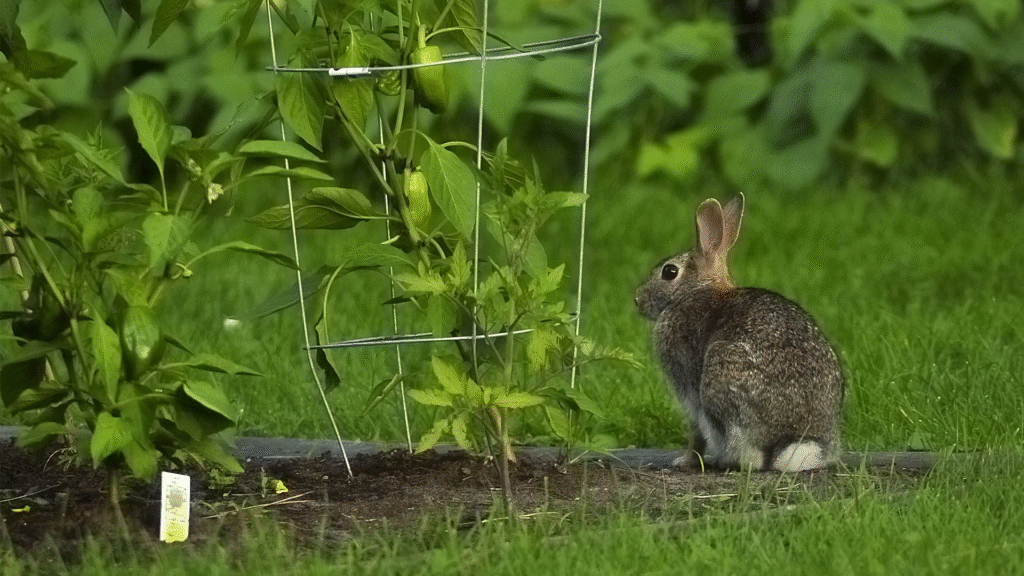
Creating an Effective Garden Fence
The most effective way of keeping out rabbits is chicken wire fencing. Install a fence that is 4 feet high and bury it at least 6 inches deep. Bend the top foot of the fence away from the garden like a security fence so rabbits can’t climb or jump over it. For smaller garden beds or individual plants, consider these approaches:
- Install chicken wire with 1-inch or smaller mesh
- Ensure the fence extends underground by at least 6 inches to prevent digging
- Create a slight outward bend at the top to prevent jumping
- For bulbs, install domes or cages of chicken wire secured over the bed
- Consider pop-up protective netting for smaller garden areas
Individual Plant Protection
For prized individual plants or young trees, targeted protection works well:
- Create wire cages around vulnerable plants
- Use plastic or biodegradable tree guards/spirals for young trees and shrubs
- Apply protective wrapping around tree trunks, especially in winter when bark is targeted
- Install plant collars around the base of susceptible plants
Natural Rabbit-Repellent Plants: Create a Protective Perimeter
Strategic planting can discourage rabbits from entering your garden. Although truly rabbit-proof plants don’t exist, rabbits tend to avoid plants with strong scents such as basil, garlic, rhubarb, hot peppers, spicy basil, and mint.
Aromatic Herbs as Rabbit Deterrents
Herbs with strong fragrances work well as natural rabbit repellents. Consider planting these around the perimeter of your garden:
- Lavender
- Rosemary
- Sage
- Thyme
- Mint (in containers to prevent spreading)
- Catmint
- Oregano
- Chives and garlic
Flowers and Ornamentals That Repel Rabbits
Several flowering perennials and bulbs are naturally rabbit-resistant. Alliums (ornamental onions) are particularly effective due to their pungent smell, and gardeners often plant them near tender lily bulbs to act as an animal deterrent. Other rabbit-resistant ornamentals include:
- Baptisia (false indigo)
- Bee balm
- Hellebores
- Foxgloves
- Black-eyed Susan
- Russian sage
- Fritillaria
- Catnip
Remember that these plants are generally rabbit-resistant but not rabbit-proof. Young rabbits may still sample them, and in times of food scarcity, rabbits might eat plants they would normally avoid.
Homemade Rabbit Repellent Sprays: Natural DIY Solutions
Creating your own rabbit deterrents can be both cost-effective and environmentally friendly. Homemade sprays are easy to make using ingredients you likely already have on hand, and they’re safe for plants in your vegetable garden while effectively deterring rabbits.
Garlic and Hot Pepper Spray
This potent mixture creates a taste and smell rabbits avoid:
Ingredients:
- 1 gallon of water
- 5-8 crushed garlic cloves
- 1 teaspoon of crushed red pepper or cayenne pepper
- 1 tablespoon of dish soap (helps the spray stick to plants)
Preparation:
- Combine all ingredients in a gallon container
- Shake well and place in direct sunlight for 1-2 days
- Strain the mixture (optional)
- Transfer to a spray bottle for application
Application:
- Spray directly on plants rabbits target
- Reapply weekly and after rainfall
- Focus on lower portions of plants and new growth
Citrus Repellent Spray
A simple mixture of water and citrus juice can effectively deter rabbits from your garden. The citrus scent is unpleasant to rabbits, and the spray will discourage them from eating your plants. To prepare:
Ingredients:
- Equal parts water and citrus juice (orange, lemon, lime)
- 1 teaspoon of dish soap
Preparation:
- Mix ingredients in a spray bottle
- Shake well before each use
Application:
- Apply to plant foliage, focusing on lower portions
- Spray around garden perimeter
- Reapply after rain and every 5-7 days
Tabasco and Soap Mixture
This simple recipe creates a taste barrier rabbits dislike:
Ingredients:
- 1 quart water
- 2 tablespoons Tabasco sauce
- 1 tablespoon liquid dish soap
Preparation:
- Combine ingredients in a spray bottle
- Shake well before each application
Application:
- Spray on plants, trees, and around the garden perimeter
- Apply to lower portions of plants where rabbits typically feed
- Reapply after rain and every 7-10 days
Scent-Based Deterrents: Odors Rabbits Avoid
Rabbits have a highly developed sense of smell, which you can exploit to keep them away from your garden.
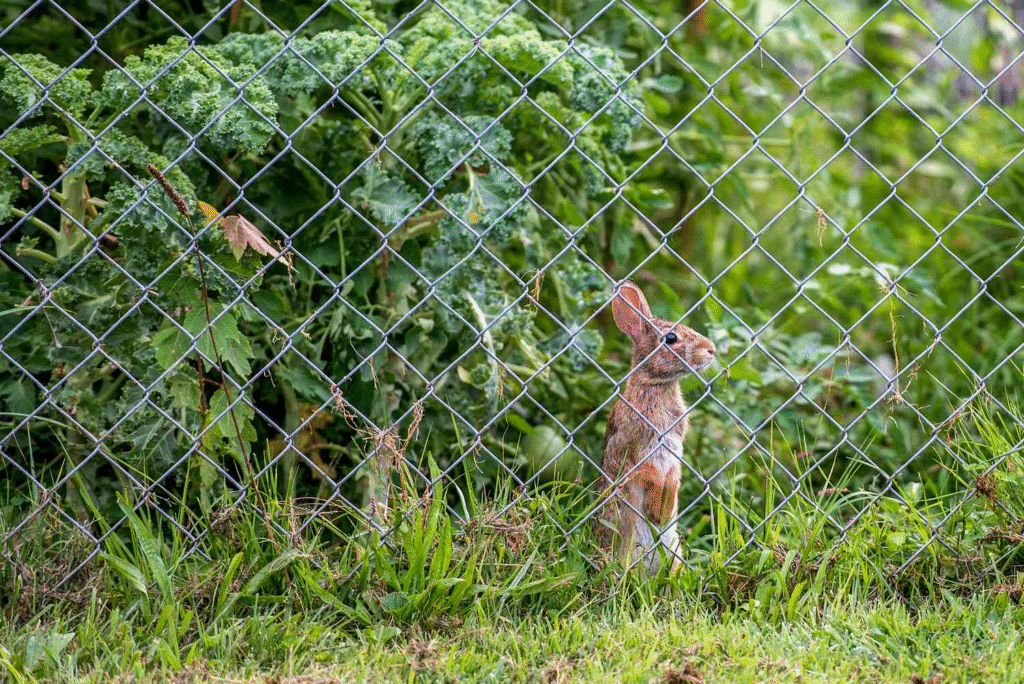
Blood Meal and Bone Meal
Bone meal works as an excellent home remedy against rabbits because they find its scent offensive. You can purchase it from local home improvement centers or hardware stores and sprinkle it around your garden. For additional effectiveness:
- Apply blood or bone meal around the perimeter of your garden
- Renew applications after heavy rain
- Combine with black pepper for enhanced effect
- Note that these products also function as fertilizers
Irish Spring Soap Method
Many gardeners report success using commercial soap products:
- Cut bars of Irish Spring soap into small cubes
- Place in mesh bags or directly in the garden
- Position soap pieces every 10-15 feet around the perimeter
- Replace when the scent diminishes or after heavy rain
Predator Urine
Commercial predator urine products (fox, coyote) can be effective:
- Apply around garden perimeter
- Reapply after rainfall
- Place at entry points to the garden
- Use according to package directions
Habitat Modification: Making Your Garden Less Appealing
Sometimes the best defense is making your property less attractive to rabbits in the first place.
Remove Rabbit Hiding Places
Female rabbits can have more than 10 babies in a litter, so if you don’t want rabbits in your yard, the last thing you want is to unintentionally create the perfect nesting site. Rabbits nest in overgrown and grassy areas, so try to keep your garden free from those types of spots.
Take these steps to eliminate rabbit habitat:
- Keep grass cut short, especially near garden areas
- Remove brush piles and debris
- Trim under shrubs and bushes
- Eliminate tall weeds and overgrown areas
- Fill in abandoned burrows (once confirmed empty)
- Seal spaces under decks, sheds, and structures
Encourage Natural Predators
Creating habitat for rabbit predators can help maintain natural balance:
- Install owl boxes or raptor perches
- Allow beneficial snakes to remain on property
- Create habitat friendly to foxes and other natural predators
- Avoid using rodenticides that might harm predators
Pet Deterrents
Household pets can be excellent rabbit deterrents:
- Allow dogs regular access to garden areas
- Let cats patrol the property
- Even if pets don’t catch rabbits, their scent and presence acts as a deterrent
Visual Deterrents and Scare Tactics
While not as reliable as physical barriers, visual deterrents can supplement your rabbit-control strategy.
Motion-Activated Devices
- Install motion-activated sprinklers
- Use ultrasonic animal repellers
- Position solar-powered predator eyes or flashing lights
- Try wind-activated spinners or pinwheels
Decoys and Scare Objects
Some gardeners use visual deterrents like metal pinwheels (their movement, shininess, and even sound frighten some rabbits), rubber snakes, and owl statues to scare rabbits away from their gardens. While effectiveness varies, these can be worth trying:
- Rotate visual deterrents regularly to prevent habituation
- Combine with other methods for best results
- Reposition regularly to maintain effectiveness
Strategic Plant Protection Techniques
Sometimes the best approach is focused protection of the most vulnerable or valuable plants.
Sacrificial Planting
Rabbits love clover and violets, plants that most people work to remove from lawns and planting beds. Letting these plants grow, at least in a few places, means rabbits will tend to feed on these first before they hit your prize plants. Consider:
- Designating a “rabbit garden” with their favorite foods
- Planting clover or other rabbit favorites away from your main garden
- Allowing certain weeds to remain in specific areas
- Using this method alongside other deterrents
Raised Bed Gardening
Elevating your plants can reduce rabbit access:
- Build raised beds at least 2-3 feet high
- Install hardware cloth beneath raised beds if rabbits are burrowing
- Combine with fencing for maximum protection
- Consider container gardening for particularly vulnerable plants
Seasonal Considerations for Rabbit Control
Different seasons require different approaches to rabbit management.
Spring Protection
Spring is when rabbits are most active and garden damage peaks:
- Apply repellents early and consistently
- Install barriers before planting
- Monitor daily for new rabbit activity
- Focus protection on seedlings and new growth
- Be especially vigilant during early morning and evening hours
Winter Tree Protection
In winter, when food is scarce as it is dormant or covered by snow, rabbits feed on the tissue between the bark and the wood. While any woody plant can be a target, some species are often preferred, including crabapple, apple, pear, redbud, and roses.
Take these steps to protect woody plants:
- Apply tree guards or hardware cloth around trunks
- Maintain protection at least 24 inches above snow level
- Check regularly that protection hasn’t loosened
- Remove guards in spring to prevent trunk damage
- Consider applying repellent sprays before heavy snow
Creating a Comprehensive Rabbit Management Plan
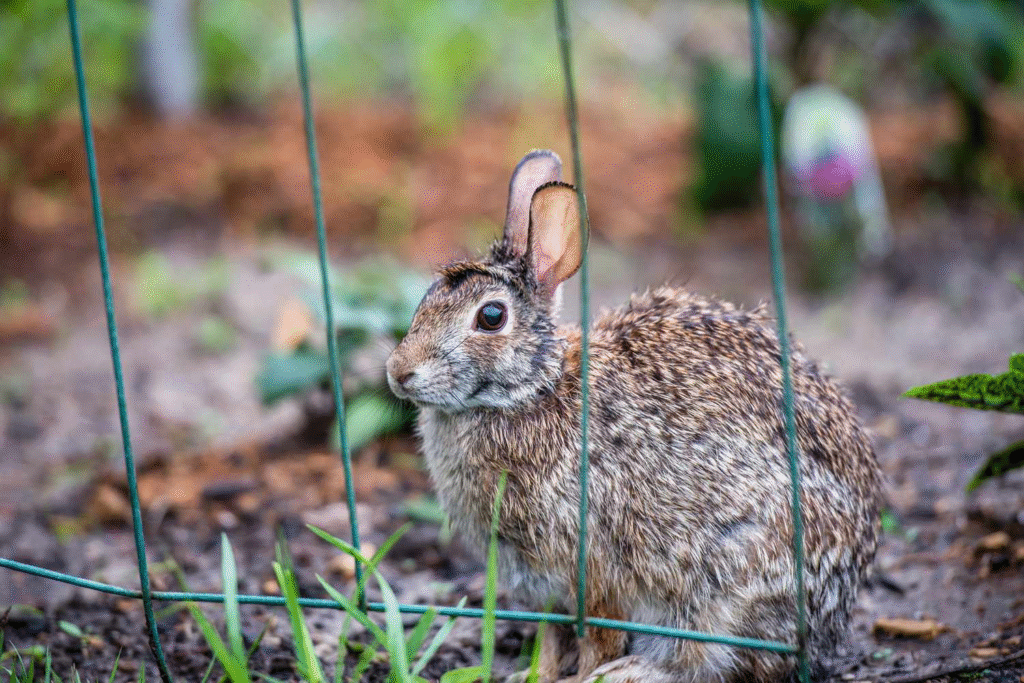
For maximum effectiveness, combine multiple strategies:
- Start with physical barriers for immediate protection
- Apply homemade repellents regularly to reinforce boundaries
- Plant rabbit-resistant species strategically around garden perimeter
- Modify habitat to make your property less attractive
- Add visual and auditory deterrents as supplementary measures
- Monitor and adjust your approach based on results
- Maintain vigilance during peak rabbit activity seasons
Final Thoughts: Coexisting with Garden Wildlife
While rabbits can be frustrating garden pests, remember they’re also part of the natural ecosystem. By implementing thoughtful, humane deterrents, you can protect your garden while allowing wildlife to thrive elsewhere. Focus on exclusion rather than elimination, and you’ll find a balance that works for both your garden and the local wildlife.
With consistent application of these strategies, you can significantly reduce rabbit damage and enjoy the fruits of your gardening labor. Remember that persistence is key—rabbits are adaptable creatures, so combining multiple deterrent methods and remaining vigilant will yield the best results for keeping rabbits out of your garden naturally.
